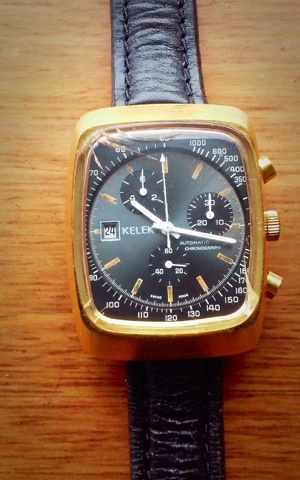Keleks with calibers 1369 & 1376 introduced in 1973-4
In
1973, the Valjoux 7750 was launched which became one of the most used
chronograph movements. Four years after,
the automatic chronograph pioneers El Primero, Cal. 11 and Seiko 6139
were launched.
In
addition, another automatic chronograph caliber was presented by a consortium
constituted by Tenor Dorly, Brac and Kelek in collaboration with Dubois Depraz
who developed the chronograph module. The initials TDBK represent the four
companies that were involved in its development. Tenor-Dorly, Dubois-Depraz,
Brac and Kelek. The base caliber an automatic with date was developed by Brac
and Tenor-Dorly, the chronograph module was subsequently added by chronograph
specialist Dubois-Depraz, and Kelek were responsible for the production.
The
new TDBK calibers were presented in two versions: the 1369 and the 1376. The
1369 is easily recognizable by the odd localization of subdials (running
seconds at 6, the minutes register between 2 and 3 and the hours register at
11). Also the date window was placed unusually: at 9.
This
caliber was initially used in watches branded Kelek and Tenor Dorly but many
other brands also started to use it: Waltham, Nivada, Precimax, Mikado, Lov,
etc and, even, the historical chronograph maker Minerva.
Despite
all the effort evolved in his development, reliability problems, the quartz
crisis and a strong competition by the Valjoux 7750 made the success achieved
by this caliber very limited and only 23000 units of both versions (1369 and
1376) were made, making it rare and collectable for the chronograph collectors.
The
1369 is a 17 jewels modular column wheel chronograph caliber which runs at
21600bph. The 1376 is a mechanical digital with a 60 minute chronograph module.
The 1376 can be seen as an attempt of the Swiss watch industry to combat the
onslaught of the digital Quartz watches from Japan. It is most likely to be the
first world jump hour chronograph.
With
a diameter of 24.8 cm and a height of 7.6 cm, they were the smallest automatic
caliber on the market, considerably smaller and thinner than the Heuer cal
11/12 and Zenith 3019 El Primero counterparts. For history remains the smallest
automatic chronograph ‘till date and in the following 20 years.The case from
both watches has 36mm wide without crown, 45mm lug to lug and is 15mm thick.
These two watches have potential in price escalations owing to the rarity in quantities and uniqueness in watch dials placement...





No comments:
Post a Comment